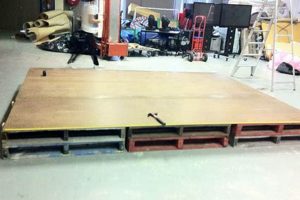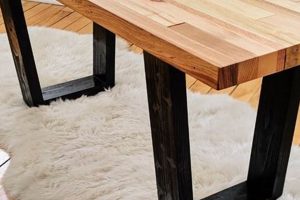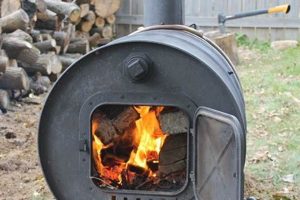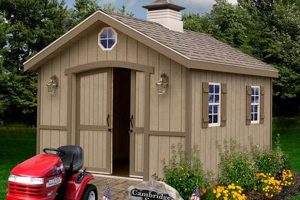Handcrafted supports for shelving, frequently constructed from lumber, offer a customizable alternative to commercially manufactured hardware. These structural components, often fashioned from readily available timber, provide a stable platform for supporting weight on wall-mounted shelves. A simple example involves cutting two pieces of pine to form a 90-degree angle, then securing them to the wall and shelf with screws.
The inherent adaptability of these homemade fixtures allows for personalized aesthetics and dimensions, catering to specific storage requirements and interior design schemes. This approach to shelving support provides a cost-effective solution while simultaneously encouraging creativity and resourcefulness. Historically, crafting one’s own furniture and fixtures was commonplace, reflecting a tradition of self-sufficiency and practical skill.
The subsequent sections will explore various designs, construction methods, and finishing techniques applicable to creating robust and visually appealing shelving supports. Attention will be given to material selection, joinery considerations, and the safe installation practices essential for ensuring the longevity and structural integrity of the finished product.
Essential Considerations for Wooden Shelving Supports
The following recommendations provide guidance for the design and construction of durable and aesthetically pleasing wooden shelving supports, ensuring both functionality and safety.
Tip 1: Material Selection: Choose lumber appropriate for the intended load. Hardwoods, such as oak or maple, offer superior strength and resistance to warping compared to softwoods like pine. Consider the aesthetic qualities of the wood grain and color to complement the surrounding dcor.
Tip 2: Precise Measurements: Accurate measurements are paramount. Prior to cutting any lumber, meticulously measure the desired shelf length, width, and the distance between supports. Errors at this stage can compromise the structural integrity and visual appeal of the finished product.
Tip 3: Secure Joinery: Employ robust joinery techniques. Mortise and tenon joints, dovetail joints, or reinforced butt joints using screws and wood glue provide superior strength compared to simple nailed connections. Ensure the joints are properly aligned and clamped during the gluing process.
Tip 4: Proper Fasteners: Select appropriate fasteners for attaching the supports to the wall and shelf. Use screws long enough to penetrate securely into wall studs, and consider using wall anchors when studs are not readily accessible. Predrill pilot holes to prevent splitting the wood.
Tip 5: Level Installation: Precise leveling is critical. Use a spirit level to ensure the supports are perfectly horizontal during installation. An unlevel shelf can result in items sliding off and create an aesthetically displeasing appearance.
Tip 6: Sanding and Finishing: Prepare the surface with thorough sanding. Progress through increasingly finer grits of sandpaper to achieve a smooth, even finish. Apply a protective finish, such as paint, stain, or varnish, to enhance the appearance and protect the wood from moisture and wear.
Tip 7: Weight Distribution Considerations: Evaluate how weight distribution affects the support. Heavy objects concentrated on one area can cause stress; redistribute weight evenly, or reinforce with additional supports as needed.
Adherence to these guidelines will result in shelving supports that are not only visually appealing but also capable of safely and reliably supporting their intended load. Careful planning and execution are essential for achieving a professional-quality result.
The subsequent section will delve into specific design variations and explore advanced construction techniques for crafting unique and customized shelving systems.
1. Material Strength
The material strength of lumber used in handcrafted shelving supports directly dictates the maximum load capacity. Softwoods, such as pine, exhibit lower tensile and compressive strength compared to hardwoods like oak or maple. Consequently, a pine bracket will deflect more under a given load than an oak bracket of identical dimensions. This deflection can lead to shelf sagging or, in extreme cases, structural failure. The selection of materials must, therefore, be carefully considered in relation to the anticipated weight to be supported.
For example, a bookshelf constructed to hold dense volumes requires supports fashioned from a high-strength hardwood, properly calculated. Conversely, supports intended for lightweight decorative items may be adequately constructed from a softwood. Real-world applications underscore the importance of this distinction: kitchen shelving laden with cookware necessitates robust hardwood construction, whereas a shelf displaying lightweight picture frames in a bedroom may suffice with softwood supports. Ignoring these principles invites potential safety hazards and aesthetic compromises.
In summary, the choice of material is a crucial determinant of shelving support performance. Failure to adequately assess the relationship between material strength and anticipated load can result in instability, damage, and potential risk. Understanding this connection ensures that homemade shelving is both functional and structurally sound.
2. Joint Integrity
Joint integrity represents a foundational aspect of wooden shelving support construction, directly influencing the stability, load-bearing capacity, and longevity of the structure. Secure and well-executed joinery prevents premature failure under stress, ensuring the shelf remains functional and safe.
- Mortise and Tenon Joints
This traditional method, involving a projecting tenon fitting snugly into a mortise, provides exceptional strength due to the increased surface area for gluing and mechanical interlocking. Its application in shelving supports is evident in craftsman-style designs where visible joinery is a design feature. The use of this joint significantly enhances resistance to shear forces compared to simpler connections.
- Dovetail Joints
Characterized by interlocking, wedge-shaped protrusions, dovetail joints offer superior resistance to tensile forces. While typically employed in drawer construction, their application in shelving supports strengthens the connection between vertical and horizontal elements, particularly in designs where aesthetic considerations prioritize exposed joinery. The interlocking nature of the joint prevents separation even under substantial load.
- Reinforced Butt Joints
Butt joints, where two pieces of wood are simply butted together, are inherently weak. However, reinforcement with screws, dowels, or metal fasteners significantly improves their integrity. In crafting shelving supports, butt joints reinforced with strategically placed screws and high-quality wood glue provide a cost-effective alternative to more complex joinery techniques. Proper screw placement and glue application are crucial for maximizing strength.
- Pocket Hole Joinery
This technique involves drilling angled holes to accommodate screws that draw the two pieces of wood together. Pocket hole joinery offers a balance of strength and ease of construction, making it suitable for shelving supports in less demanding applications. While not as visually appealing as exposed dovetails or mortise and tenon joints, pocket holes provide a concealed and efficient method for creating sturdy connections.
The selection and execution of appropriate joint techniques are paramount for achieving a robust and reliable wooden shelving system. The chosen method must align with the anticipated load, aesthetic preferences, and the skill level of the builder. Proper joinery ensures the supports adequately perform their function, preventing sagging, instability, and potential hazards.
3. Load Capacity
The ability of handcrafted wooden shelving supports to bear weight, known as load capacity, is inextricably linked to their design and construction. The dimensions of the lumber used, the type of wood, and the joinery techniques employed directly influence the maximum weight a support can safely sustain. Insufficient load capacity can lead to structural failure, resulting in damage to property and potential injury. For example, a shelf intended to hold books but constructed with inadequate supports may sag over time, eventually collapsing under the weight. The relationship is causal: substandard materials or construction result in reduced load capacity and increased risk of failure.
Real-world examples demonstrate the importance of understanding load capacity. A shelf designed to hold heavy kitchen appliances necessitates robust supports constructed from hardwood like oak, properly secured to wall studs. Conversely, a decorative shelf intended for lightweight items may suffice with smaller supports made from softwood. Consider a scenario where a homeowner, unaware of load capacity limitations, installs shelving to hold audio equipment. If the supports are not adequately reinforced, the weight of the equipment can cause them to fail, resulting in damage to the equipment and potentially the wall. Precise calculations, based on material properties and design parameters, are essential for determining safe load limits.
In summary, load capacity is a critical consideration in the design and construction of wooden shelving supports. Neglecting this factor can lead to structural instability and potential hazards. By carefully selecting materials, employing appropriate joinery techniques, and calculating safe load limits, one can create shelving that is both aesthetically pleasing and structurally sound. Ensuring adequate load capacity transforms a decorative element into a reliable and safe storage solution.
4. Mounting Security
The secure attachment of handcrafted wooden shelving supports to a wall constitutes a critical safety and functional consideration. The stability and load-bearing capacity of a shelving unit are directly contingent upon the robustness of the mounting system. Improper or inadequate mounting can result in shelf collapse, posing a risk of property damage and potential physical harm.
- Wall Stud Engagement
Direct attachment to wall studs provides the most secure mounting solution. Wall studs, the vertical framing members within a wall, offer substantial holding power for screws or lag bolts. Locating and utilizing studs is essential, particularly when supporting heavy loads. The absence of stud engagement necessitates the use of alternative anchoring methods, often with reduced load-bearing capacity. Real-world applications include using a stud finder to locate studs behind drywall, marking their location, and driving screws through the shelf bracket and into the stud. The implication here is an increase of shelf durability and a much higher chance that the shelf will last a very long time.
- Anchor Selection
When wall studs are inaccessible, appropriate wall anchors are required. Numerous anchor types exist, each with specific load ratings and installation requirements. Toggle bolts, expansion anchors, and molly bolts provide varying degrees of holding power in drywall, plaster, or concrete. Selecting an anchor appropriate for both the wall material and the anticipated load is crucial. An example would be using heavy-duty toggle bolts when mounting a shelf to hold books to drywall when no stud is available. The implication is that the incorrect anchor type can pull out of the wall, resulting in shelf collapse.
- Fastener Length and Diameter
The dimensions of the fasteners used to secure shelving supports directly influence the strength of the connection. Screws or lag bolts of sufficient length and diameter are necessary to penetrate adequately into wall studs or anchors. Insufficient fastener length compromises holding power, while excessive diameter can damage the wood or wall material. Using screws that are too short to properly engage a wall stud, for example, will result in a weakened connection and potential shelf failure. This could be avoided by measuring the thickness of the drywall and the bracket, and then making sure the screw length exceeds that. The implication is that the fastener should match the job.
- Installation Technique
Proper installation technique is paramount for maximizing the effectiveness of any mounting system. This includes pre-drilling pilot holes to prevent splitting the wood, ensuring that fasteners are driven straight and securely, and verifying that anchors are fully expanded or engaged. Improper installation can significantly reduce the load-bearing capacity of the mounting system, even when high-quality materials are used. An example of improper installation is driving a screw at an angle or failing to fully tighten an anchor, resulting in a compromised connection. This implies that it is better to take your time during the install so that the shelf will last as long as possible.
Mounting security is a non-negotiable element in DIY wooden shelving projects. Selecting appropriate mounting hardware and employing correct installation techniques are critical for ensuring the safety, stability, and longevity of the shelving unit. Careful attention to these details transforms a potentially hazardous installation into a reliable and functional storage solution.
5. Dimensional Accuracy
Dimensional accuracy, in the context of handcrafted wooden shelving supports, refers to the precision with which components are cut and assembled. This precision directly influences the structural integrity, aesthetic appeal, and overall functionality of the shelving system. Deviation from specified dimensions can lead to instability, misalignment, and a compromised load-bearing capacity. For example, if two shelf supports intended to be identical in height vary even slightly, the shelf will not sit level, potentially causing items to slide off. This example underscores the importance of accurate measurements and precise cutting techniques.
The implications of dimensional inaccuracies extend beyond mere aesthetics. Consider a situation where the angle of a support brace is slightly off. This seemingly minor error can significantly reduce the support’s ability to bear weight, as the load is not distributed evenly across the joint. A real-world consequence is a shelving unit collapsing under a load it was otherwise designed to handle. Practical applications demand careful attention to detail; a carpenter employing a miter saw to cut precise angles for support braces ensures optimal load distribution and structural stability. Consistent application of accurate dimensions contributes directly to the long-term reliability and safety of the shelving system.
In summary, dimensional accuracy serves as a cornerstone of successful wooden shelving support construction. Challenges in achieving this accuracy can be mitigated through meticulous measurement, the use of precision tools, and a thorough understanding of woodworking principles. Adherence to dimensional specifications ensures that the finished product is not only visually pleasing but also capable of fulfilling its intended function safely and reliably. The pursuit of accuracy is therefore inextricably linked to the success of any DIY shelving project.
6. Aesthetic Consistency
Aesthetic consistency, within the context of crafting wooden shelving supports, denotes the harmonious integration of the shelving unit’s appearance with the surrounding environment. This extends beyond mere visual appeal to encompass a cohesive design that complements the existing dcor, architectural style, and overall ambiance of the space. When shelving supports exhibit aesthetic inconsistency, the resulting visual discord can detract from the room’s intended character and reduce its perceived value. For example, rustic, handcrafted supports may appear out of place in a minimalist, modern interior, disrupting the room’s clean lines and understated elegance. A direct consequence of neglecting aesthetic consistency is a visually fragmented space that lacks a sense of unity and intentional design.
Achieving aesthetic harmony necessitates careful consideration of several factors, including wood species, finish, and design style. The choice of lumber, whether a light-toned maple or a rich, dark walnut, significantly influences the overall aesthetic. Similarly, the finish applied to the supports, ranging from a clear sealant to a vibrant paint color, must align with the existing color palette and design motifs. The design style of the supports themselves, whether simple and utilitarian or ornate and decorative, should complement the architectural features and furniture within the room. For instance, supports mimicking traditional molding profiles can seamlessly integrate with classically styled interiors, while sleek, minimalist designs suit contemporary spaces. Mismatched styles can draw attention to the supports in a negative way, creating a visual distraction rather than a cohesive element.
In summary, aesthetic consistency is an indispensable component of successful wooden shelving support design. Ignoring this principle can lead to visual discord and a diminished sense of harmony within the space. By carefully considering wood species, finish, and design style, and ensuring their alignment with the surrounding environment, one can create shelving that enhances the aesthetic appeal of the room and contributes to its overall sense of cohesion. The pursuit of aesthetic consistency transforms functional shelving into an integrated design element that elevates the visual character of the space.
7. Surface Finishing
Surface finishing directly impacts the aesthetic appeal and functional longevity of wooden shelving supports. This process, encompassing sanding, staining, painting, and sealing, serves multiple purposes: it enhances the wood’s natural beauty, protects it from environmental damage, and ensures a smooth, user-friendly surface. Inadequate or improperly applied surface finishing can lead to premature wear, discoloration, and susceptibility to moisture damage, ultimately reducing the lifespan and visual appeal of the supports. For example, shelving supports left unfinished or with a poorly applied sealant in a humid environment are prone to warping, mold growth, and structural weakening. Therefore, surface finishing is not merely cosmetic but a crucial step in preserving the wood’s integrity.
The selection of appropriate finishing products is paramount. Water-based finishes offer low VOC emissions and ease of cleanup, making them suitable for indoor applications. Oil-based finishes provide superior durability and water resistance, ideal for shelving supports in kitchens or bathrooms. Paints offer a wide range of color options and can be used to create a specific aesthetic. Regardless of the chosen finish, proper preparation is essential. Sanding the wood to a smooth surface ensures proper adhesion and a uniform appearance. Applying multiple thin coats, allowing adequate drying time between each, yields a more durable and visually appealing finish. Examples: A light sanding followed by application of a wood conditioner can improve the absorption of the chosen wood stain. This ensures an even color across the surface of the “diy wood shelf bracket”. Then it can be covered with several coats of clear polyurethane finish to protect the stain. The impact being that you can then showcase the shelf support better.
In summary, surface finishing plays a vital role in the creation and preservation of wooden shelving supports. It is a multi-faceted process that combines aesthetics with functionality. While challenges may arise in selecting the appropriate products and mastering application techniques, the benefits of a well-executed finish are undeniable. A properly finished shelf support resists wear, enhances visual appeal, and contributes to the overall longevity of the shelving system, transforming it from a simple structure into a durable and aesthetically pleasing element of the room.
Frequently Asked Questions
The following provides answers to commonly asked questions regarding the design, construction, and installation of wooden shelving supports. The information aims to clarify potential points of confusion and guide individuals toward informed decisions.
Question 1: What type of wood is most suitable for crafting robust shelving supports?
Hardwoods, such as oak, maple, or walnut, offer superior strength and resistance to warping compared to softwoods like pine or fir. The selection should align with the anticipated load and desired aesthetic qualities.
Question 2: How does one accurately determine the appropriate dimensions for shelving supports?
Dimensions depend on the shelf’s length, intended load, and desired aesthetic. Consider the distance between supports, the shelf’s thickness, and the overall design scheme. Consult load-bearing charts for specific wood species.
Question 3: What are the crucial considerations for ensuring secure wall mounting?
Locating and utilizing wall studs provides the most secure attachment. When studs are inaccessible, appropriate wall anchors are essential. Fastener length and diameter must be sufficient to penetrate the wall and support the intended load.
Question 4: How can one prevent wood from splitting during screw installation?
Predrilling pilot holes slightly smaller than the screw diameter prevents splitting. Ensure the screw is aligned properly and driven in a straight path. Use a sharp drill bit for clean hole creation.
Question 5: What are effective techniques for achieving a professional-quality finish?
Thorough sanding, progressing through increasingly finer grits, creates a smooth surface. Apply multiple thin coats of finish, allowing adequate drying time between each. Consider the compatibility of the finish with the wood species.
Question 6: How does one account for weight distribution on a shelf with multiple supports?
Distribute the load evenly across the shelf to minimize stress on individual supports. Consider placing heavier items closer to the supports. Reinforce the shelf with additional supports as needed.
Adherence to these guidelines contributes to the creation of safe, functional, and aesthetically pleasing wooden shelving units. Prior planning and careful execution are essential for achieving optimal results.
The subsequent section will explore advanced design variations and customization options for wooden shelving supports, allowing for greater creative expression and tailored functionality.
DIY Wood Shelf Brackets
The preceding exploration of “diy wood shelf brackets” has highlighted critical aspects of their design, construction, and installation. Material selection, joint integrity, mounting security, dimensional accuracy, aesthetic consistency, and surface finishing were identified as fundamental principles. Adherence to these principles ensures both structural stability and visual appeal. The inherent customizability of self-made supports allows for unique adaptation to specific needs and aesthetic preferences.
The careful application of knowledge regarding load capacity and construction techniques is essential for creating safe and reliable shelving systems. Continued refinement of skills in woodworking and design will further enhance the potential for creating functional and visually compelling storage solutions. Future innovations in materials and techniques promise to expand the possibilities within this field, contributing to both practicality and artistry in interior design.


![[DIY Guide] Easy DIY Wood Window Shutters You Can Build! The DIY Hub: Creative Crafts, Repairs & Life Hacks [DIY Guide] Easy DIY Wood Window Shutters You Can Build! | The DIY Hub: Creative Crafts, Repairs & Life Hacks](https://craftingdiycenter.com/wp-content/uploads/2025/07/th-3579-300x200.jpg)




